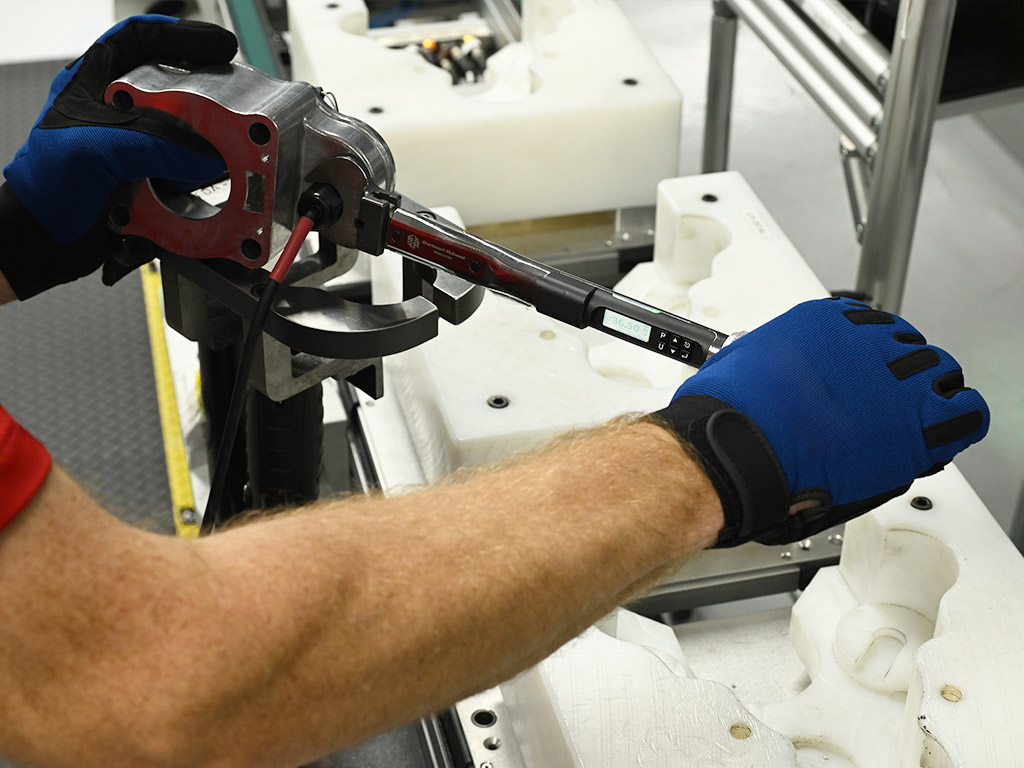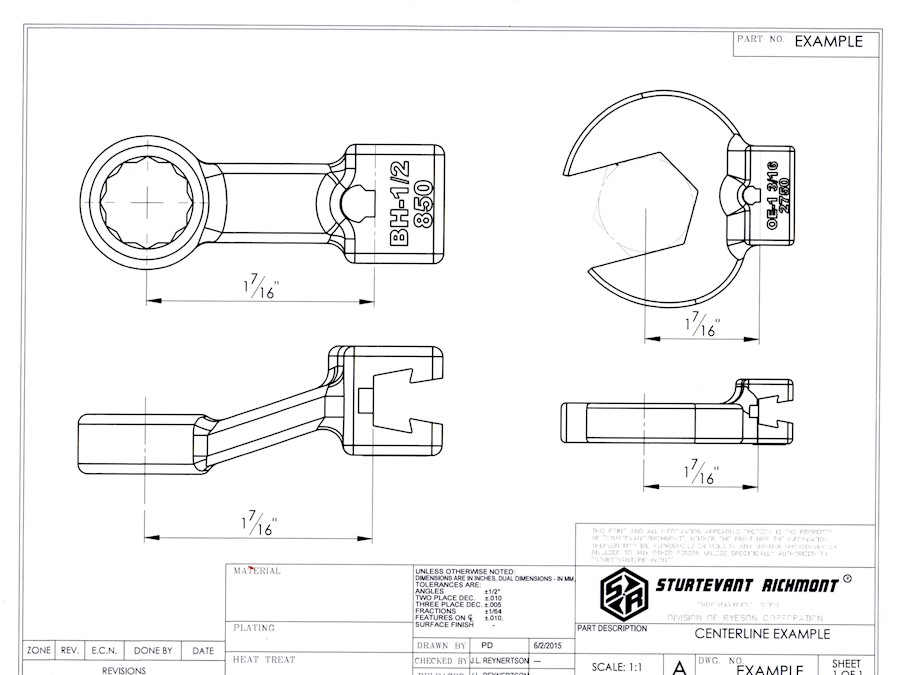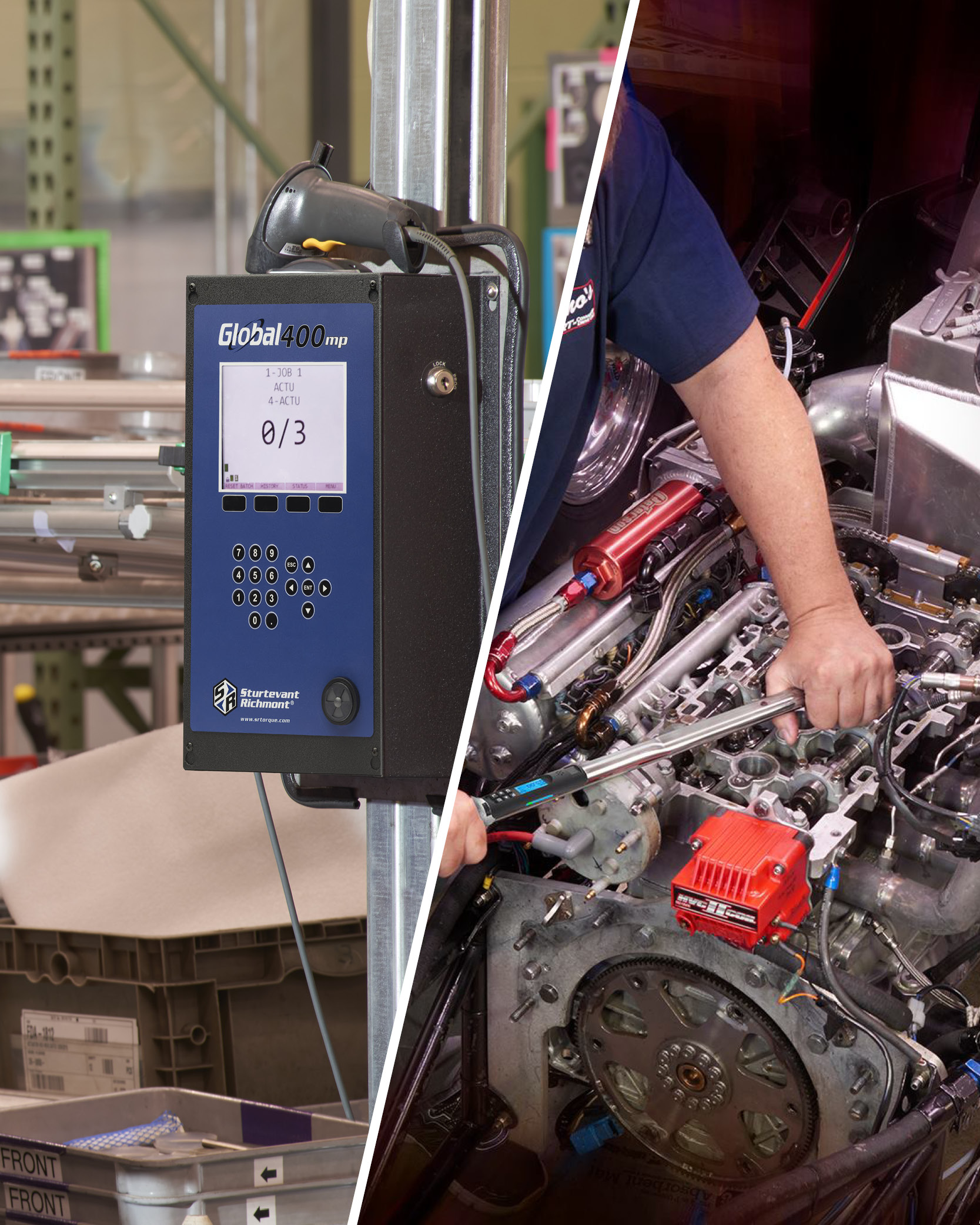Torque Fundamentals: The Key to Efficiency and Accuracy
Torque plays a critical role in many industries, ensuring bolts, nuts, and fasteners are tightened to precise specifications for the proper assembly and functionality of machinery and structures. It is also key to understanding the forces acting on rotating components like engines, motors, gears and other mechanical systems.
Torque Knowledge
Torque is essential in various fields where it's crucial for tightening bolts, nuts, and fasteners to specific levels to ensure proper assembly and functionality of machinery and structures.
Torque is also fundamental in understanding how forces act upon rotating objects, such as engines, motors, gears, and other mechanical systems.
Torque is essential in various fields where it's crucial for tightening bolts, nuts, and fasteners to specific levels to ensure proper assembly and funtionality of machinery and structures.
Torque is also fundamental in understanding how forces act upon rotating objects, such as engines, motors, gears, and other mechanical systems.


Torque 101:
what is torque and why it is important
The power of error-proofing
We specialize in design, engineering, and the manufacturing of torque tools with a focus on error-proofing solutions that improve efficiency and eliminate mistakes. Our approach to error-proofing if build on three main strategies:




Our tools are engineered to reduce human influence and ensure accurate torque application, such as our click wrenches with flattened cases that minimize side-loading for consistent results.




Sturtevant Richmont tools are known for their exceptional accuracy and durability, backed by superior materials like aerospace-grade aluminum and high-grade steel. Our meticulous design ensures better calibration and long-lasting performance.




This strategy focuses on supporting operators with systems that guide their actions, such as our Global 400 series that organizes tools and provides alerts to prevent errors during assembly processes.
By integrating these strategies, our tools and systems empower operators to work with confidence, improving performance and maintaining the highest standards of craftsmanship. These error-proofing measures help reduce mistakes, increase consistency, and ultimately optimize productivity across a range of industries.
What is the
common centerline?


What is the
common centerline?
The centerline is the distance between the center of the fastener and the top of the wrench where the heads stops and the wrench starts.
The formula for torque application is T=F x r x sinθ
T = Torque; F = linear force; r = distance measured from the axis of rotation to where the application of linear force takes place
Distance in the torque equation "r" can be changed by changing the length of the centerline. This changes torque output.
Sturtevant Richmont wrenches all come with two common centerlines. Heads 1 1/4" and less have 1 7⁄16” (36.5 mm) common centerline and heads 1 5/16" and more have 3 7⁄8” (98.4mm) common centerline. This means you can change between heads with the same common centerline and not change the torque output.
If you change to the second common centerline, we have a torque slide ruler that immediately tells you the new torque output result.
Additional torque terminology
Residual torque, or breakaway torque, is the force required to initiate movement in a fastener that has already been tightened. it measures the remaining clamp load or tension in a joint, indicating how tight the fastener remains after initial tightening. To measure residual torque, tools detect the peak torque just before movement begins and note any subsequent drop in torque.
There are two primary methods for measuring this: one uses a zero-degree target angle, and the other uses a specific degree of rotation, typically 3 degrees. The accuracy of residual torque measurements depends on the correct settings and the operator's skill level. Proper measurement requires applying force in the same direction as the original tightening and not loosening the fastener, as loosening alters the joint's condition.
Residual torque is crucial for audits and inspections, ensuring fasteners maintain their intended tension over time. Sturtevant Richmont offers specialized digital torque and angle wrenches equipped with residual torque functionality for precise measurements.
In the context of torque tools, the term "chemistry" refers to the compatibility and interaction between the different components or materials used in their construction and operation, rather than the scientific discipline of chemistry. It encompasses factors like material compatibility, component interaction, lubrication, and calibration.
While voltage itself is not directly related to torque, it plays a crucial role in powering electric or electronic torque tools. The voltage level affects the performance, efficiency, and power output of these tools, with higher voltage sometimes indicating greater power or torque capability.
"Chemistry" in torque tools also includes:
- Material Compatibility Ensuring the materials used (metals, alloys, plastics) work together for durability, accuracy, and minimal friction
- Component Interaction The seamless operation of gears, sensors, and calibration mechanisms to ensure consistent performance
- Lubrication and Friction Proper lubrication minimizes friction, enhancing tool efficiency and lifespan
- Calibration and Precision The accuracy of calibration and the stability of the tool's performance over time
In essence, "chemistry" symbolizes the harmonious functioning of all parts of a torque tool, ensuring optimal performance and reliability.
A torque transducer is a device used to measure and convert torque (rotational force) into an electrical signal that can be recorded or monitored. It is an essential tool in various applications where precise torque measurement is required, such as manufacturing, testing, automotive, aerospace, and research. Torque transducers provide a precise measurement of rotational force, allowing for accurate monitoring and control in a wide range of mechanical and industrial applications.
A torque tester is a device used to measure and verify the torque (rotational force) applied to a fastener, tool, or mechanical component. It is commonly used in quality control, testing, and calibration to ensure that the correct torque is applied during assembly processes, ensuring reliability, safety, and proper performance.
A torque tester usually uses a torque sensor or torque transducer to detect and measure the amount of torque applied to a component or tool. The tester records the torque data and often displays the measurement on a digital or analog readout. Some models include features like peak hold (to capture the maximum torque value), overload protection, and the ability to store or export data for further analysis.
Breakaway torque, also known as residual torque, refers to the force required to initiate movement in a previously tightened fastener. It represents the clamp load or tightness of the fastener in a joint. When measuring residual torque, tools assess the torque needed to transition a static fastener to a dynamic state, overcoming the friction that holds it in place.
Tools measuring residual torque detect the peak torque just before the fastener starts moving and note the subsequent torque drop. There are two methods for measuring residual torque: one involves setting zero degrees as the target angle to capture the torque drop when the fastener begins to move, while the other sets a specific degree of rotation, typically 3 degrees, to record the torque value at that point.
The accuracy of residual torque measurements hinges on appropriate parameter settings. Skilled operators might use a zero-degree target angle, while less experienced ones may opt for the 3-degree rotation setting. These measurements are crucial for auditing previously tightened fasteners to ensure compliance with torque specifications.
Sturtevant Richmont offers various digital torque and angle wrenches equipped with residual torque functionality for accurate measurements. The appropriate direction to apply force to establish breakaway torque is crucial—typically in the same direction the fastener was initially tightened.
It's crucial not to loosen the fastener during the breakaway torque measurement, as doing so alters the joint's condition, undermining the accuracy of the audit. Instead, tightening the fastener to capture the moment of movement provides a more precise breakaway torque reading without compromising the joint.
For further information on Sturtevant Richmont tools' capabilities in measuring residual torque and resolving auditing challenges, contacting a local Sturtevant Richmont Torque Expert is recommended.
In the context of torque tools, the term "chemistry" doesn't directly refer to the scientific discipline involving elements and compounds. Instead, it can refer to the compatibility and interaction between different components or materials used in the construction and functioning of torque tools.
Here, "chemistry" might be used metaphorically to describe how different elements or parts of a torque tool interact with each other to ensure optimal performance, accuracy, and reliability.
For instance, it might refer to:
• Material Compatibility: The selection of materials used in constructing torque tools—such as alloys, metals, plastics, or composites—needs to ensure they work harmoniously together. The materials should resist wear, provide durability, maintain accuracy, and reduce friction while operating.
• Component Interaction: Within a torque tool, various components like gears, sensors, clutches, and calibration mechanisms need to work together seamlessly. The chemistry between these parts ensures smooth operation, accurate torque measurement, and consistent performance.
• Lubrication and Friction: Chemistry might also refer to the lubrication systems employed within torque tools. The selection of appropriate lubricants and their interactions with different surfaces minimizes friction, enhancing the tool's efficiency and lifespan.
• Calibration and Precision: The chemistry of calibration refers to how accurately torque tools are calibrated and how well they maintain their calibration over time. This involves the interaction between the calibration standards, sensors, and mechanisms within the tool.
In essence, while the term "chemistry" in torque tools doesn't directly relate to the scientific field, it symbolizes the synergy and compatibility between various components, materials, and mechanisms within these tools, ensuring their optimal functionality and reliability.
General Info
We specialize in designing, engineering, manufacturing, and marketing torque tools, but the key value they offer lies in error-proofing solutions. This concept originated from the earliest commercial torque wrench and has been ingrained in every tool they've developed since. These approaches work together to eliminate errors and increase efficiency.
Our approach to error-proofing revolves around three main strategies:
- Error Proofing By Design: Tools are engineered to minimize human influence in torque application and testing processes, aiming to reduce potential errors.
- Error Proofing By Behavior Modification: These tools are designed to encourage operators to perform their tasks accurately, fostering a culture of precision and excellence in craftsmanship.
- Error Proofing By Guidance: Providing operators with feedback and guidance, ensuring the correct tool is selected, used correctly, and returned appropriately, streamlining assembly processes.
Error Proofing by Design
The roots of torque-related error-proofing date back to 1924 when Walter P. Chrysler faced challenges with unevenly torqued heads on aluminum block engines. This led to the invention of the deflecting beam torque wrench, providing repeatable tightening for engine heads. Chrysler licensed Paul Sturtevant to manufacture this wrench, marking the genesis of the error-proofing industry.
Since then, we have championed "Error Proofing By Design" across our product line. Our tools are designed to reduce human influence on torque application, exemplified by the flattened case of their click wrenches. The flattened case prevents side loading, ensuring accuracy in torque calculation both in labs and on the shop floor.
Our micrometer adjustable torque wrenches, digital torque wrenches, and preset click wrenches all incorporate the flattened case design. Notably, our torque screwdrivers were engineered to neutralize the impact of thrust force, maintaining accuracy and repeatability across different operational conditions—an embodiment of "Error Proofing By Design."
For additional information on error-proofing strategies, we provide insights into behavior modification, operator guidance, and various error-proofing scenarios. These resources explore the balance between tool and operator responsibility, cost implications, and the significance of a common centerline in error-proofing strategies.
Error Proofing by Modification
Our focus on error-proofing involves minimizing human error in torque application and testing processes. Acknowledging human variability in assembly, our "Error Proofing By Design" approach aims to reduce human influence on tools and torque output. However, recognizing that this method doesn't eliminate all errors, we have introduced "Error Proofing By Behavior Modification."
This newer approach addresses human interaction with tools. It recognizes that workers strive to perform well but may require continuous feedback and support, especially with new tasks or tools. To address this, our intelligent tools and process monitor/controllers offer visual and auditory feedback on each fastening, indicating whether it's acceptable (OK) or not (NOK). Operators are required to correct nonconforming fastenings before moving forward, providing the coaching and positive reinforcement they seek.
Our PST 1200 and PST 2000 Series tools offer a detailed view of fastenings, displaying ideal fastening profiles and providing air pressure and time signatures for each fastener. These tools empower operators to analyze non-compliant fastenings, identifying potential causes such as premature clutch release or cross-threading, leading to improved performance through pattern analysis.
Even our non-radio-equipped tools, like the Exacta 2 and 3000 Series Exacta 2, offer visual feedback with a digital display indicating torque compliance through color-coded cues (yellow/green/red).
W. Edwards Deming said that people do their best and often it is the system that prevents them from doing so. Our integrated, systematic approach to error proofing supports people in doing their best. Our system supports rather than interferes. Here is an example.
We see workers on car lines using our Exacta 2 digital wrenches to make the final adjustments on car doors to ensure the fit is perfect and the doors don't leak. Right after the water test, the operators make final adjustments. They use the digital wrench because of the +/- 1% indicated value accuracy. But they also like the display with the yellow/green/red feedback. We see a lot of real craftsmen working with pride knowing when the car leaves their station those doors are about as perfect as they can be.
Error Proof by Guidance
We aligns with W. Edwards Deming's philosophy, emphasizing that eliminating obstacles to quality allows operators to showcase pride in their craftsmanship. Our "Error Proofing By Guidance" strategy aims to remove hindrances to quality and support teams in delivering excellent work.
Acknowledging that many errors occur outside the system, our guidance-based approach has been meticulously developed to address various assembly line distractions and challenges associated with torque-related tasks. We’ve designed systems to cover a wide range of potential assembly issues.
Our Global 400 and GIM 400 organize multiple tools, holding tools, light/socket trays, and more, providing guidance to operators at crucial assembly points. Intelligent tools like the Exacta 2 wrenches offer visual cues—changing colors to signal torque levels and alerting operators to potential over-torque.
Our SLTC FM 2.4 GHz A3 click wrenches combined with the Global Series monitors/controllers convert torque values to time, modifying operator behavior and providing guidance. The system prevents counting or recognizing incomplete work until the predetermined torque is achieved, offering visual and auditory cues for non-compliant fastenings.
We emphasize flexibility and control in our error-proofing systems, allowing customization based on individual organizational needs rather than imposing rigid procedures. Even their calibration and test equipment incorporate error-proofing measures, guiding operators during potential faults or inaccuracies.
Residual torque, also known as breakaway torque, refers to the amount of force required to initiate motion in a previously tightened or static fastener. When a fastener, such as a bolt or a nut, is tightened and then subsequently left in a static state without any additional force applied, residual torque measures the force necessary to break the static friction and set the fastener in motion again.
This measurement is crucial for understanding the level of clamp load or tension that remains in the joint after the initial tightening process. Residual torque indicates the tightness or retention of a fastener within the assembly and is often used during quality audits or inspections to ensure that fasteners maintain their intended level of tightness over time.
Tools designed to measure residual torque detect and record the peak torque just before the fastener begins to move and may note any subsequent torque drop. The accurate assessment of residual torque helps determine whether a fastener has loosened or relaxed from its initially tightened state and provides insights into the integrity of the joint or assembly.
In summary, residual torque is the force required to overcome static friction and initiate movement in a previously tightened fastener, serving as a crucial metric for assessing the retained tension in a joint.
Voltage doesn't directly relate to torque itself; however, in the context of torque tools or devices, voltage often refers to the power supply or the electrical energy used to operate these tools.
In many cases, torque tools, especially electric or electronic ones, might require a power supply to operate. This power supply could be in the form of batteries or an external electrical power source. The voltage level typically indicates the strength or potential of the electrical energy provided to run these tools.
For instance, some electric torque wrenches or tools might run on batteries, such as lithium-ion batteries, which have a specific voltage rating. The voltage level can impact the performance, efficiency, and power output of these tools. A higher voltage can sometimes imply higher power output or increased torque capabilities in electric torque tools, but this isn't a universal rule.
Therefore, while voltage is not directly related to torque itself, it plays a role in providing the necessary electrical energy to operate torque tools, impacting their overall performance and capabilities.
What is torque?
Torque is a measure of the rotational force applied to an object around an axis or a pivot point. It's commonly associated with the turning or twisting force that causes an object to rotate. Mathematically, torque is calculated as the product of the force applied and the distance from the axis of rotation to the point where the force is exerted. It's often expressed in units such as Newton-meters (Nm) or foot-pounds (ft-lb).
In practical terms, torque is essential in various fields, especially in mechanics and engineering, where it's crucial for tightening bolts, nuts, and fasteners to specific levels to ensure proper assembly and functionality of machinery and structures. Torque is also fundamental in understanding how forces act upon rotating objects, such as engines, motors, gears, and other mechanical systems.



